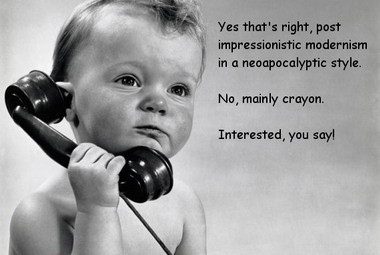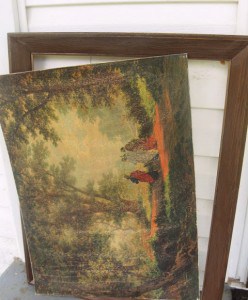10 Great Tips That’ll Help You Get Your Art Accepted Into A Gallery
Getting your artwork on display to the public for the first time can seem very daunting, and the thought of wandering into a art gallery carrying some of your prized paintings, only to have the proprietor give them a cursory glance and turn you down, can be very demoralising.
Fortunately, with a bit of forward planning, there are some things you can do that will greatly help your chances of success. So let’s get into it:
1) Try not to walk into the gallery looking like you’ve just been dragged through a hedge backwards.
As artists we’re pretty good at the ‘distressed’ look, necessity dictates that when you’re throwing paint around all day you don’t want to be wearing your finest paisley trousers and sporting your ‘going out’ cravat, right. However, when you’re trying to be taken seriously by a business, it will help your chances no end if you look relatively tidy and professional when you approach them.
2) Do a bit of reconnaissance ( disguise optional ).
Before you approach a gallery to ask if they will display your art, wander in and have a look around to see if they show work similar to your own. There may not be much point in approaching a gallery that only shows humongous abstract paintings, if you paint miniature wildlife paintings. Having said that, an art gallery is a business, and if they think they can sell your work they may still take you on, so it’s always worth asking.
3) Contact the gallery and make an appointment first.
Never just drop in on the off chance hoping/assuming that the gallery proprietor has the time to stand and look at your work right there and then, get in touch and make an appointment first. Not only will this allow the owner to make some time to look at your work, but it makes you look more professional.
An added bonus of making an appointment first, is that you will have already made that daunting initial first contact before you turn up with your work, which more often than not reassures you that the gallery proprietor isn’t quite as scary as you thought, and in fact, is really very nice.
4) Only take properly framed paintings which will show off your work to its best.
If you walk in to the gallery carrying floppy pieces of watercolour paper with dirty finger marks all over them, or poorly framed paintings with wonky corners and that have a piece of your Dad’s fishing line on the back to hang them up, it won’t help your cause. If the gallery does decide to display your work, then you’re more than likely going to have to get your paintings framed, so get some/all of the paintings you plan on taking in professionally framed beforehand.
5) If the gallery you’re approaching offers a framing service, ask them to frame your paintings.
This is of course a great way to subtly make contact with the gallery, and start building a working relationship, without having to start from scratch. You never know, they may like your work so much when they frame it, that THEY ask YOU if you would like to display some of your art in their gallery.
6) Decide on an approximate price for your paintings.
Of course, this needs to be flexible, and when you get chatting to the proprietor they will be able to advise you if your figure is way out. Do a little research beforehand, look at other paintings/artists similar to you as a gauge. Ideally, you want to be able to say a figure when the gallery asks you where you would like to price your paintings. What you DON’T want to say, is that you have no idea.
7) Have your contact details written down and ready to hand over.
Preferably have a pamphlet or business card to hand over with your phone number on. If you can’t afford to have this done professionally, and you have access to a home printer, you can make your own pamphlets in most word processor programs these days cheaply and fairly easily. A lot of programs have a few pamphlet templates you can choose from, and all you have to do is add images and text.
8 ) If you have your own website then put the address down with your contact details.
Do not think having a website is a substitute for taking your paintings into the gallery for them to see in the flesh. Most galleries won’t accept artwork on the basis of what they see on a website. Besides, your art will always look better in real life than on a monitor.
9) Try not to be intimidated.
I think artists in general are quite shy people, and walking into a gallery with lots of wonderful expensive looking paintings on the walls can make you feel quite inferior. If you’re not fortunate enough to have a large purpose built studio at home that you create your art in, this doesn’t mean that your work isn’t as good as other artists. Remember that most paintings in most galleries were created in cramped makeshift conditions in a house full of dogs, cats and children.
10) Lastly, after all your efforts, if the gallery do turn you down don’t forget to ask politely the reasons why.
If it’s the quality of your work that they don’t think is quite up to scratch, then don’t be too disappointed. This just means you need to go away and continue to paint like crazy, until your level of skill has improved and you can approach them again. It may be that your subject matter has let you down, and although loving your miniature paintings of flowers, the gallery would rather display enormous landscape paintings. If this happens, then you must either try a different gallery, or consider changing your subject matter – whatever the reasons are, it’s in your interests to know, so that you can go away and take action.
Good luck ( not that you need it ) and happy painting.
Chris
I look forward to some great comments below, and if you enjoyed this post and found it useful, please share it, thanks.










Thank you, Chris, for taking time out to help us. I’ve sold many paintings at Craft fairs, commissions, gotten many ribbons (including Best in Show) from City Fair events, and have sold 7 paintings via the local Taubman Museum of Art in Roanoke, VA, for shows that were strictly for supporting the local SPCA ( wherein sales were split as half donations & half artist sales). How would I approach this Museum as a stand alone Artist WITHOUT having the odds attached in my favor from having had my work sold through programs sorted by the Museum as I’ve done in the past? Thank you, again, for your help. Katie Thomas
Hi Katie, I’m glad you find my blog useful. I’d approach the museum as I describe, and just mention that you have sold work there in the past. It doesn’t matter that it was part of the SPCA program, they will know your work sells and be more likely to take you on. Good luck and let me know how you go ~ Chris
Hi Chris,
Thank you for this great advice!
I have been into, and after a snoop around, have spoken to the staff at a local gallery which was set up specifically for new artists. They actively encourage painters, sculptors etc who haven’t yet dared to brave the ‘established’ galleries.
They rent you a set amount of space on their wall for just £10 pw, and you can have from 1-6 weeks. This makes it financially worth doing, plus knowing that everyone else exhibiting there is in the same boat makes it a whole lot more comfortable to take that step.
Thank you for your encouragement!
Hi Tania, That’s terrific! Their renting a wall system sounds ideal, good price too, and I’m glad my blog post helped with a little encouragement. Let me know when you sell your fist piece of art! 🙂 Chris
Thanks very much for the advice Chris. I really found this helpful as approaching a gallery is something I still must do. Your list has definitely reduced some anxiety.
Thanks and all the best.
Hi Kyle, I’m glad you found it helpful, best of luck getting your work out there – let me know how you get on. Chris
Hi Louise, It would depend on the gallery no doubt, and as a first contact it’s always good practice to email/phone and make an appointment. This could of course include showing some of your work digitally, but in my experience before any gallery proprietor will agree to exhibit your work they will want to see it first hand. If a gallery is slow in replying to your initial email, try phoning them.
Thanks Chris, So on the button.
Though I have sold and had commissions I am yet to approach a gallery.This is a valuable list to add to my own research..
Hi Steve, I’m glad you found it useful. Good luck when you do approach a gallery, you’ll do fine!
Do not sell, ” Posts Note Psychic Artist”.
Kimberly Sparks
This is really insightful. Though i have had exhibitions outside Africa, i have sought gallery representation especially in the UK. One actually showed interest on the condition that i can’t be based outside Europe. Now I see a bit of the reason in No.8, it’s such a struggle. Thanks again!
You’re welcome, glad you found it helpful Amarachi. Chris